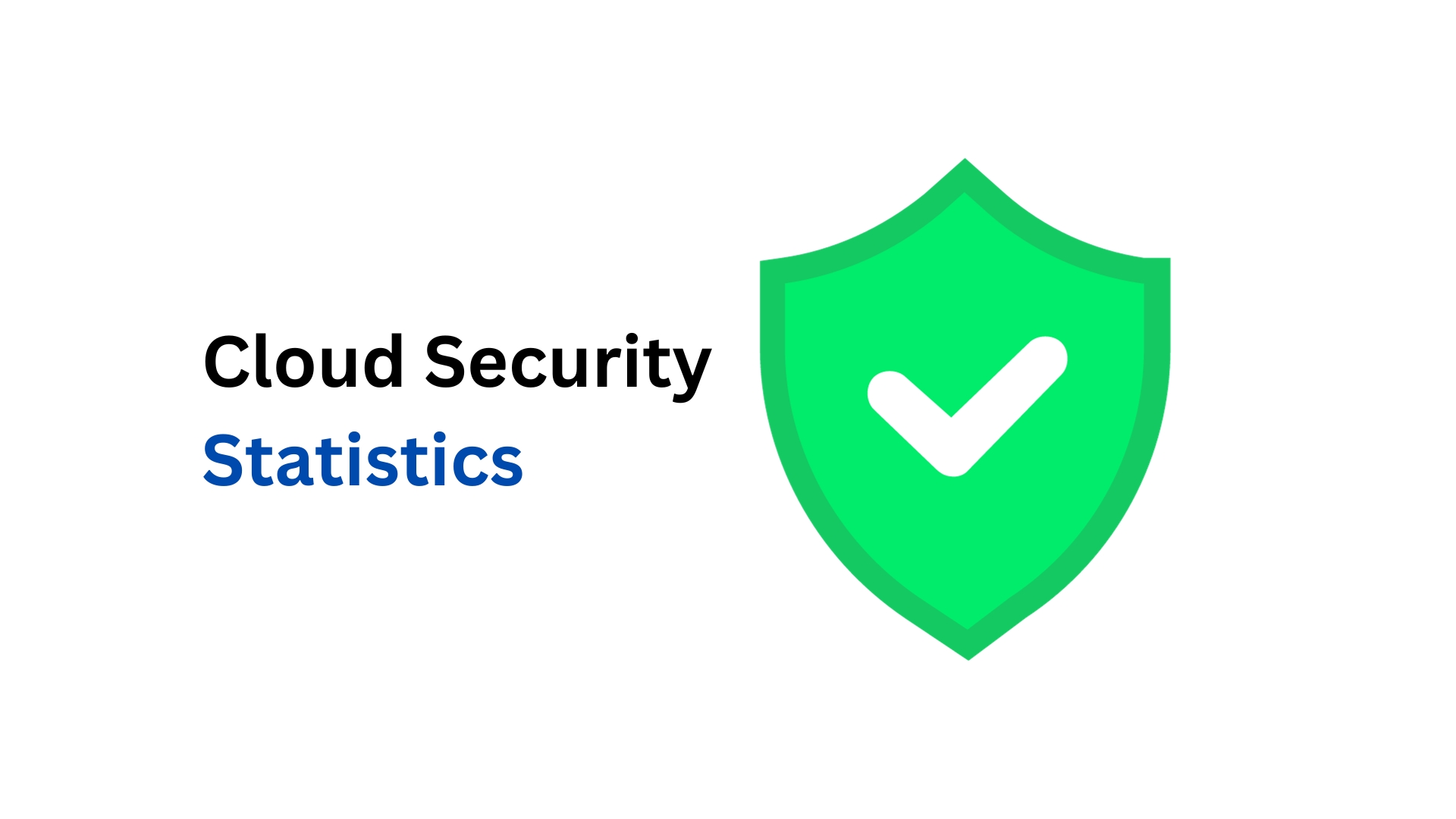45+ Piracy Statistics: Don’t Be a Victim in 2023
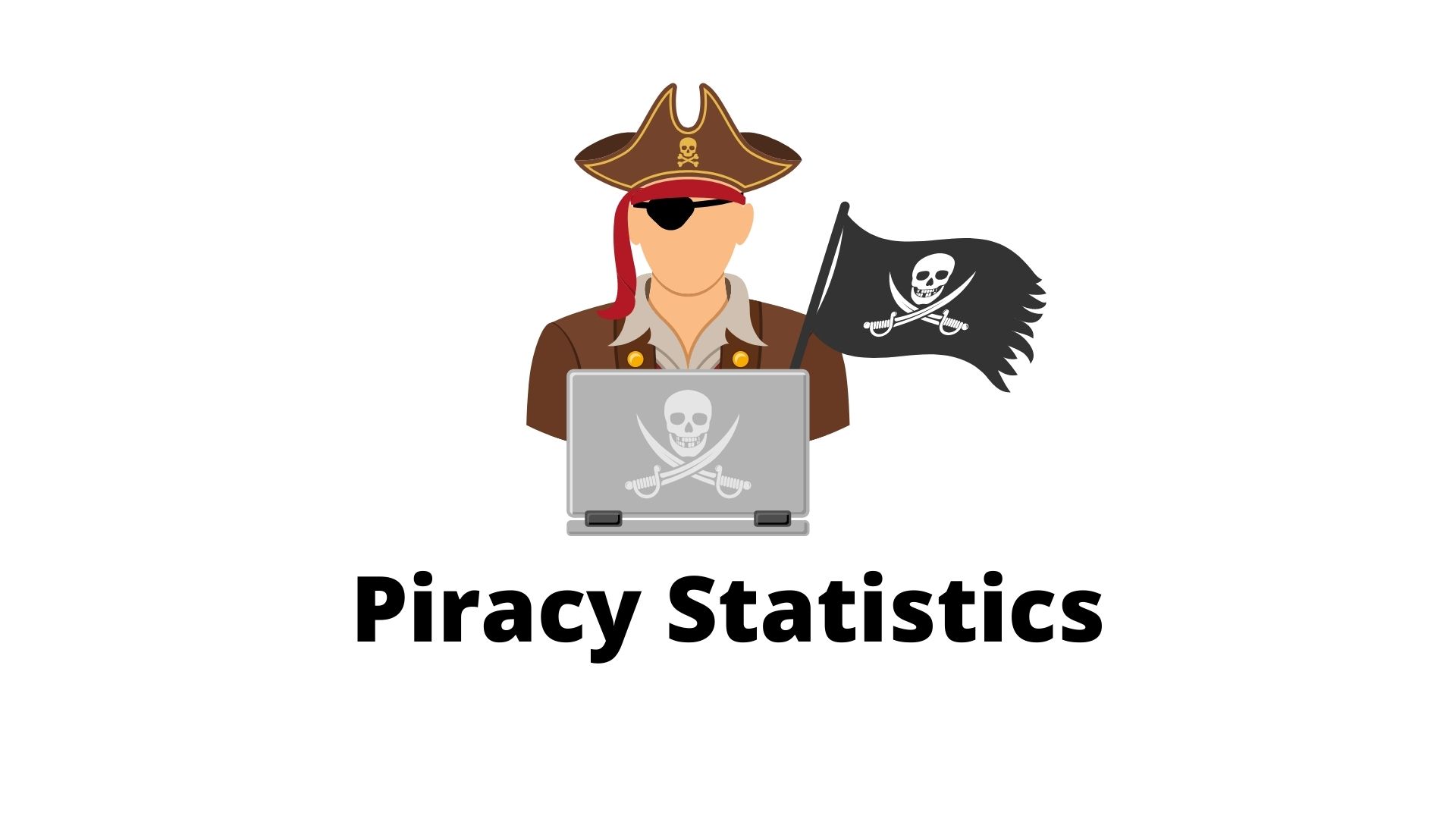
Page Contents
- 45+ Piracy Statistics You Need To Know in 2023
- Key Piracy Statistics and Facts (Editor’s choice)
- Internet Piracy Statistics
- Movie Piracy Predictions and Statistics
- Music Piracy Statistics: Find the Hidden Sounds
- Software Piracy Statistics: A Pervasive Epidemic
- Pirates' Demographic Profile
- Piracy Statistics by Global Traffic
- Piracy Statistics by mos pirated content on the Internet in 2023
- Conclusion
45+ Piracy Statistics You Need To Know in 2023
Piracy Statistics: Do you know why online piracy gets called that? The answer is quite simple. You are aware of how sea pirates rob people without their consent. When we embark on an online “sea expedition” to use something that is not our own, this is what transpires.
Although we don't imply that you do it, you might boldly identify as an online pirate if you did. It certainly sounds cool. We'll discuss this in more detail in our piracy statistics.
You can board our ship anytime, but it is entirely your responsibility. It will be full of pirated treasures. All Hands Hoy
Key Piracy Statistics and Facts (Editor’s choice)
- The US is the global leader, with 13.5 billion visits to pirate websites in 2021.
- By 2021, there were 182 billion visits to pirate websites worldwide.
- 67% of all pirate websites are hosted in North America and Western Europe.
- In 2021, China ranked first in the world for the use of pirated software.
- Television piracy accounted for 50.3% of total piracy traffic in 2021.
- Every year, the United States loses $12.5 billion due to music piracy.
- For 2020 alone, Amazon, Google, and Facebook paid pirate operations tens of millions of dollars.
- In Central/Eastern Europe and the Asia Pacific regions, 57% of computer users admit to having downloaded pirated software at least once.
- Unlicensed software is still used in most countries at rates of 50% or higher.
- In 2021, China ranked first in the world for the use of pirated software.
- A malware attack costs $2.4 million and takes an average of 243 days to detect. It takes around 50 days to stop.
- The United States content and distribution sector suffered annual losses of $29.2 to $71.0 billion due to digital video piracy.
- The US online movie and TV industry is projected to lose $11.58 billion to piracy in 2022.
- Every year, approximately 127 billion episodes of US TV shows are illegally downloaded or watched.
- The USA topped the list of countries with 12.5 billion visits to pirate websites during the COVID-19 pandemic in 2020.
- More than 230 billion people worldwide view pirated TV series and movies yearly.
- In 2004, the average pirate was a guy between the ages of 16 to 24 who lived in an urban area.
- The age group of 30-44 is the one with the highest likelihood of book piracy.
- More than 230 billion people worldwide view pirated TV series and movies yearly.
- In 2023, the top-rated films that were targeted for Piracy were Spider-Man- No Way Home (21%), The Batman (13%), and Doctor Strange (10%).
Internet Piracy Statistics
Let's now take a look at the actual situation. While some people choose to pay for several online products and services, others would instead access them through back doors. Although it may seem unfair, this is how it works. This article will focus solely on facts and take a neutral stance.
#1. The United States is the global leader, with 13.5 billion visits to pirate websites in 2021.
Russia is in the second rank with 7.2 billion visits, followed by India with 6.5 and China with 5.9 billion visits, respectively. This data is for the first 9 months of 2021.
Remember that downloading files from pirated websites can result in the theft of personal information and malware infections. This should be a significant concern due to the high number of cases of digital piracy.
(Source: Akamai)
#2. In 2020, major Fortune 500 companies paid $100 million for advertisements on pirate operators.
Very well indeed… That's a significant discovery! Can you even imagine it? Let's look into who did what and was caught.
A few Fortune 500 businesses are interested in assisting the online piracy sector. Receiving $100 million for a single year is a considerable amount of money. In addition, 73% of this sum was paid by Amazon, Facebook, and Google ads for piracy applications. Our statistics about piracy are becoming more and more enjoyable. This data is for the prior year and comes from a poll published in August 2021.
(Source: Digital Citizens Alliance)
#3. Due to a 2020 court decision, the Pirate Bay can't be accessed in the Netherlands.
The Amsterdam Court of Appeal issued a dynamic block injunction in 2020 for two major (ISPs) Dutch internet service providers. As a result, users can't access pirated websites as their internet service provider was forced to block them.
Although this case may seem like a small success story, since there is nothing stopping Dutchmen from using virtual private network (VPN) services, it is much more. It has been a decade since the EU fought against internet piracy. This court ruling serves as a precedent and point of reference for similar cases in the future.
(Source: ITIF)
#4. Visits to Pirate Websites by Country.
What does piracy entail, and what are the effects on society? MUSO company that deals with these inquiries daily. Additionally, it records and analyses the most exciting pirate patterns across various media categories. According to the company's 2018 report, more than 190 billion people visited pirate websites in 2018. The following table shows the list:
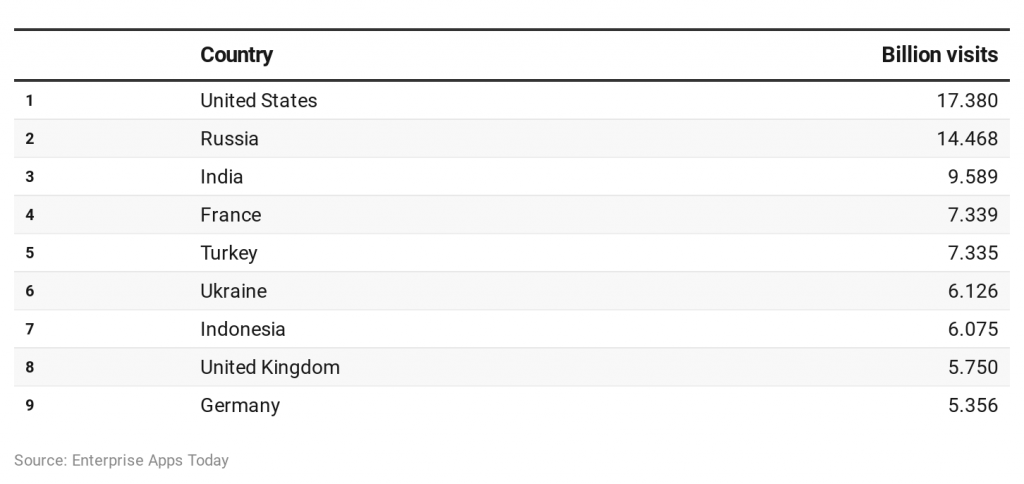
Recent online piracy stats reveal that streaming websites, which are still the preferred resource for most users, received more than 50% of these recorded visits. However, direct download and torrent websites are equally popular.
It is interesting to see that the United Kingdom managed to rank among the top 10 despite numerous prohibitions on pirate websites and widespread criticism of these actions. The United States came out on top with roughly 28 billion illegal downloads, followed by Brazil and India.
One significant participant is missing, though: China. China is often seen as the most populous country in the world and is often described as a country where unauthorized downloading dominates the market. On the other hand, China has only tallied a modest total of 4.6 billion visits in 2019, which is insufficient to lift it out of 18th place.
(Source: MUSO)
#5. By 2021, there were 182 billion visits to pirate websites worldwide.
This is about 15% more than the previous year when there were more than 130 billion visits. These statistics include visits to software, TV, music, movies, and publishing websites. These are the most popular types of piracy.
Approximately 62% of visitors visited the pirate website directly; more than 28% found it via a web search engine. The rest were sent to display advertisements, emails, referrals, social signals, and other methods.
(Source: MUSO)
#6. The whole anti-piracy team of Netflix is in charge of handling the problems.
Every hour, Netflix creates original, protected content. In addition, many series and films are still available on several pirate platforms. The company has established a special department to address this issue. Netflix is also a member of two of the most powerful global anti-piracy organizations, the Alliance For Creativity & Entertainment and the Motion Picture Association.
(Source: Coast)
#7. Google began deindexing pirated domains in 2021.
This means that these domains will not appear in Google search results. These measures were taken in Brazil as well as many European countries, including France, Sweden, the UK, Netherlands, and Norway. Google voluntarily adhered to court orders against piracy websites, with the Amsterdam court ruling of 2020 being the first “culprit.”
(Source: TorrentFreak)
Movie Piracy Predictions and Statistics
We all love watching our favorite movies and TV shows via VOD (video on demand) platforms such as Amazon Prime, Hulu, HBO, Netflix, etc. This content is copyrighted and, therefore, can be targeted by web piracy operators.
#8. Website visits related to movie piracy increased by 31% worldwide between Q1 to Q4 of 2021.
Guess who is the leader in film piracy by demand? This time, it's not the United States; they are second. India is the first, followed by Turkey.
(Source: MUSO)
#9. Unauthorized streaming is punishable by a year in jail or a fine of thousands of dollars.
Streaming is prohibited in the USA from 2022, as long as it contains proprietary content. If you host a stream without authorization, you could face harsh consequences. Be aware that you could face a criminal charge if you violate US law, including the Copyright Act. The maximum punishment is a $100,000 fine, one year in jail, or two times the amount of the loss or gain in money.
However, there is some good news regarding watching illegal streaming. While downloading illegal streams is prohibited, watching them is legal.
Making copies of someone else's work is prohibited by US copyright rules, even for personal use. Copyright laws in the USA prohibit you from making copies of another person's work for personal use.
(Source: All Connect)
#10. In 2022, piracy could cause the United States to lose $11.58 billion in the online television and film industries.
These stats on internet piracy are based on forecasts, but they may prove accurate. We can see how large the numbers are in previous statistics.
Piracy is expected to cause China to lose $9.78 billion in movie and TV revenue in 2022. This assumption is logical because China is a leader in pirated content use.
(Source: Statista)
#11. Television piracy accounted for 50.3% of total piracy traffic in 2021.
The Television type of piracy includes watching anime series, live sports events, and TV shows. The year 2021 was successful for TV piracy websites. They received 91.6 billion visits, around 13.2% more than in 2020. The United States, China, and Russia are the world leaders in this industry.
(Source: MUSO)
#12. Online piracy could result in a loss of $51.6 billion in worldwide film and online TV revenue by 2022.
There is a need for such content, which is why pirated TV and movie databases exist. The piracy industry has the potential to generate revenue when there is demand. If you are curious about the amount of money lost due to piracy, the estimate of more than $50 billion might surprise you.
On the other side, we can leverage the marketing adage that says “to be where your customers are” in this situation.
And where is that exactly? Obviously, pirate websites. As a result, it is a win-win situation for the piracy domain and advertisers.
True, even though it is sad.
(Source: Statista)
Music Piracy Statistics: Find the Hidden Sounds
You are aware of the adage “water is life.” Some people can replace the water part with music. The music then becomes life.
These people can't live without listening to music, which is a great thing. However, music might originate from either legal or illegal sources.
This will be discussed below.
#13. More than one-third of people who listen to music still pirate it.
IFPI conducted a global survey in April 2018 about how consumers use and pirate music. Researchers investigated thousands of licensed and unlicensed service options to confirm their suspicions.
The resulting stats on media piracy demonstrate that over 38% of consumers continue accessing their preferred music through copyright infringement.
(Source: IFPI)
#14. In 2017, users of pirate websites made 73.9 billion to get music illegally, and 53.2 billion visits were made to stream or download movies.
Many people believe that the popularity of on-demand services has ended piracy; however, stats on media piracy over the last few years disprove this idea. A rise in music download demand indicates that illegal music downloading is more common than people might expect. This is due to the popularity of streaming services such as Spotify and FireStick.
(Source: MUSO)
#15. Each year, the United States loses $12.5 billion due to music piracy.
Each year, those are the effects of music piracy on the US economy. Additionally, sound recording piracy also results in the loss of more than 71,000 jobs. Each year, the American government loses at least $422 million in taxes.
(Source: RIAA)
#16. There has been a drop of 65% in music piracy between 2017-2021.
This is the good news. Comparing Q4 of 2021 with Q4 of 2020, there has been an 18.6% increase. This substantial content piracy increase is due to music stream rippers – sites that allow you to download and rip YouTube audio. Their share in 2021 among all music piracy websites is 39.2%.
(Source: MUSO)
#17. More than 87% of people who want to download music now do it via their mobile devices, which is a sign of growing mobile piracy.
Desktop computers used to be the best for illegally downloading music. However, mobile devices are increasingly popular, and people can access pirated TV and music content through their mobile devices.
According to MUSO's statistics on music piracy, as of 2018, desktops were still preferred among movie pirates. However, since then, there have been tremendous advancements in mobile technology, making it more accessible for pirates to access websites that offer unauthorized music downloads or stream movies on their smartphones.
(Source: MUSO)
#18. Stream-ripping accounts for 32% of music piracy.
Stream-ripping can be described as exactly what it sounds. It involves illegally downloading an audio file that can be played on any streaming platform, such as YouTube and Spotify. It is currently the most common trend in music pirates. There are many streaming sites and tools that anyone can find by simply doing a Google search.
Customers can avoid paying hefty membership costs for services that provide offline music listening by using this method of music piracy.
(Source: Music Consumer Insight Report)
#19. Between 2016 and 2019, the UK observed a 1390% increase in the use of stream-ripping services.
According to a survey by the licensing body PRS for Music, this enormous increase outpaces all other illicit online music activities. Stream-ripping websites now make up more than 80% of the top 50 music piracy sites, and the trend isn't slowing down.
(Source: PRS for Music)
#20. India won the gold medal in 2021 for music piracy.
Iran receives the silver medal, while the United States takes the bronze medal. While Iran and India used most illegal streaming sites, 63% of US users favored stream rippers.
(Source: MUSO)
#21. In 2008, there were 800 pirated songs on the average teen's iPod.
Online statistics about music piracy revealed that people between the ages of 14 to 25 have an average of 800 pirated tracks on their iPods. Nearly half of them stated that they would be open to allowing people to copy hundreds or even thousands of music files at once by sharing their digital music.
Even though fewer people now use traditional iPods, the practice of sharing and downloading music illegally persists.
(Source: The Times)
#22. 83% of adults in the UK who pirate music claim they did it because there were no paid options.
Is downloading music from YouTube against the law? This and other questions were asked of more than 1,000 UK people in one of the most recent MUSO polls. Moreover, half of the respondents admitted to once or twice downloading music without permission. More than 83% said that they searched legal sources first to locate the music in question.
In response to the query “Is downloading music against the law?” Respondents provided the following justifications as to why they had received content illegally:
- 34.7% stated that some music is not available in their area.
- 34.9% blamed the inaccessibility of music on subscription channels.
- 35.2% chose it because it was free.
(Source: MUSO)
#23. RIAA won a case against two-stream rippers for $83 million.
After a prolonged battle against FLVTO.biz and 2conv.com for many years, the RIAA (Recording Industry Association of America) finally won. These websites allow users to rip YouTube content previously blocked in the United States.
(Source: Forbes)
Software Piracy Statistics: A Pervasive Epidemic
The same laws that apply to copyright violations for books, music, television, and movies also apply to commercial software.
Typically, fully functional commercial software is the most frequently pirated. Although shareware and freeware are likewise copyrighted, they can be freely downloaded from the internet and are less likely to be pirated.
#24. Worldwide visits to software-piracy websites were 3.2 billion in Q3 of 2021.
That measure has been rising steadily since Q3 of 2020 when there were 2.28 billion users. It was a remarkable increase of 92 million visits in a single year.
(Source: Statista)
#25. In 2021, most visitors to software pirate websites are from China.
The United States and Russia follow China. The number of people visiting websites that sell pirated software increased worldwide by 13.1% in 2021 compared to 2020. Even when we look at the prior five years in more detail, the year 2021 still saw the highest traffic to these websites.
(Source: MUSO)
#26. In Central/Eastern Europe and the Asia Pacific regions, 57% of computer users admit to having downloaded pirated software at least once.
BSA surveyed more than 15,000 people from 33 countries. They asked a straightforward question: “How frequently do you acquire pirated or unlicensed software?”
The results of their software piracy statistics showed that 57% of people confessed to pirating software, although none were detained for doing so.
(Source: BSA: The Software Alliance)
#27. China's illegally-installed software might be as high as 69% by 2025.
In China, installing unlicensed software is a widespread activity. The projection for Russia is 58%. These two countries serve as the best case studies for software piracy in future potential growth.
(Source: Statista)
#28. Worldwide software piracy rates fell to 37% in 2017, a drop of 2% over the previous two years.
This survey only focused on PC software piracy. These digital piracy statistics indicate a slight decrease in the number of unlicensed software. However, it is essential to remember that software piracy remains widespread.
(Source: BSA: The Software Alliance)
#29. The piracy theft cost the software industry $46.3 billion between 2015 and 2017.
Software piracy costs the software business tens of billions of dollars every year.
According to this BSA poll, there was an increase in PC shipments to developing nations with emerging economies that led to the rise in stolen software between 2015 and 2017. High software piracy rates statistics show that those living in less developed countries are more likely to copy software. This is where the software industry suffers the most.
(Source: BSA: The Software Alliance)
#30. Unlicensed software is still used in the majority of countries at rates of 50% or higher.
The copyright owner loses money each time someone downloads software from one of the many pirated websites out there. In addition, software piracy is regarded as a federal offense, and in some circumstances, the offender may be required to pay federal statutory damages.
However, stats on digital piracy are still lower for individuals who are aware of the risks, such as Americans. The prevalence of pirated software is often 50% or more in nations that ignore software piracy.
(Source: BSA: The Software Alliance)
#31. Two out of every five copies of distributed software are not paid worldwide.
According to statistics on software piracy, two out of every five copies of software programs downloaded worldwide are not paid. Unfortunately, there is an unwritten rule in the software industry: the more expensive and precious your software product is, the more likely consumers will download pirated versions of it.
(Source: Revulytics)
#32. A company's profitability can increase by 11% with a 20% boost in software compliance.
Companies that abide by anti-piracy rules and actively work to increase software compliance make money over time.
According to the most recent statistics on piracy, businesses may anticipate an average gain in revenues of 11% when they make practical efforts to improve their bottom line. To ensure the programs currently executing on the network are fully licensed, software asset management is necessary.
(Source: BSA: The Software Alliance)
#33. A malware attack costs $2.4 million and takes an average of 243 days to detect. It takes around 50 days to stop.
When organizations purchase or install an unlicensed software product, there is a one in three chance that it may contain malware. This is possibly the most compelling argument against installing unlicensed software and running the danger of a virus attack out of all the digital piracy data we've gathered.
Many businesses increasingly view improving software compliance as a security and economic requirement in the fight against online piracy.
(Source: BSA: The Software Alliance)
Film Piracy Rates: A Powerful Comeback In The Era Of Streaming
#34. With 106.9 billion visits to TV-pirating websites in 2017, TV shows continue to be the most famous content among pirates.
Pirated content includes more than just music and movies; popular TV shows are in high demand more than ever; with 106.9 billion visits to websites hosting pirated films in 2017, TV episodes continued to be the most famous content among pirates.
Is it prohibited to stream movies in the USA? For the nation's lawmakers, this issue is still unclear.
However, streaming services have minimal content and show only a few popular TV shows, so it's not surprising that pirated movie websites are rising in America.
(Source: MUSO)
#35. Over 80% of online piracy worldwide can be attributed to illegal streaming services.
Over four-fifths of all online piracy-related activities are connected to unlawful streaming sites, according to research done by the U.S. Chamber of Commerce's Global Innovation Policy Center and NERA Economic Consulting. This trend is particularly prominent in the television and movie industries.
(Source: GIPC, NERA Economic Consulting)
#36. Pirated video content receives more than 230 billion views per year.
The United States is home to approximately 15 billion 12.8 billion TV shows and 2.2 billion films. Similar preferences are evident in other regions of the world, with 44.7 billion views for movies and 215 billion views for TV shows.
(Source: Forbes & Statista)
#37. The total number of episodes from US-produced TV programs illegally downloaded or streamed annually is 126.7 billion.
The study examined the economic impact of digital video piracy on the United States economy. The study's movie piracy in America shows that there has been an unprecedented increase in the number of digitally pirated TV episodes.
This will significantly impact the US economy, both in terms of lost revenue from the movie industry and tax revenue.
(Source: National Economic Research Associates)
#38. The United States content and distribution sector suffered annual losses of $29.2 to $71.0 billion due to digital video piracy.
According to statistics on digital piracy, the impact on the American content creation sector may range from 11% to 24% in lost revenue, lessening the advantages that the streaming service sector offered.
(Source: GIPC, NERA Economic Consulting)
#39. In Europe, North America, and the Asia-Pacific, almost 24% of the bandwidth is used for illegally uploading or downloading unauthorized content.
Internet piracy worldwide is expanding quickly despite tighter US regulations and the possibility of severe fines. 23.8% of internet bandwidth is used for piracy across three major regions: Europe, North America, and the Asia-Pacific.
The same survey discovered that 178.7 million distinct internet users in those three regions used BitTorrent to pirate digital content.
(Source: Creative Future)
#40. Digital piracy is a significant threat to the worldwide movie industry's revenues. It costs between $40 and $97.1 billion annually.
This analysis used a minimum replacement rate of 14% and a maximum replacement rate of 34% to determine the precise amount lost to digital piracy. This calculation was made to assume that between 66% and 86% of digital piracy doesn't genuinely replace paid consumption.
Film piracy statistics then revealed widespread piracy's total value and revenue lost. Film industry revenues are lost between $40 billion and $97.1 billion, while television industry revenue ranges from $39.3 and $95.4 billion.
(Source: GIPC, NERA Economic Consulting)
#41. Users downloading illegal content increase their risk of malware infection by 28 times.
Even if you've never downloaded anything illegally, you probably know someone who has. It is not unexpected that many pirate websites provide malware-infected files.
According to statistics for film piracy obtained from various studies, the device you use to pirate movies could become infected with malware, which can compromise your personal data within seconds and put you in danger of becoming a victim of identity theft. Consider all this, and you will see why pirating your movie for free is no longer a good idea.
You are 28 times more likely to get infected if you pirate content than those who do not.
(Source: Digital Citizens Alliance)
#42. 76% of workers say they won't disclose the unauthorized usage of software at their company.
Is piracy a crime? Of course, more than 3-quarters of workers would ignore this unethical behavior in the workplace.
A total of 13% of employees agreed that they would ignore it to maintain their position inside the organization. Around 22%of employees stated that they would not want a “whistleblower” reputation, and 46% of employees said that they just don't care.
Pirates' Demographic Profile
#43. In 2004, the average pirate was a guy between the ages of 16 to 24 who lived in an urban area.
Here are some historical statistics for you: Statistics on media piracy from the MPA survey conducted in 2004 show that the 16–24 age range had by far the most significant percentage of internet infringement. This study examined the piracy rates of every country and found that 58% of pirates belonged to this age group.
The figures in the United States were significantly higher; More than 71% of illegal downloaders were between 16 and 24 years old in the middle of the 2000s. Piracy is now much more commonplace than it was 15 years ago. Additionally, anyone can become a pirate today, regardless of gender, location, and age.
(Source: MPA)
#44. In 2018, content theft was considerably more fairly distributed across age groups, with people in the United Kingdom between the ages of 25 to 34 being the most likely to do so.
Incredibly, things have changed since then! In 2004, more than half of pirates were young boys or men. However, this stereotype was no longer valid in 2018. These statistics on piracy show that 36% of pirates in the UK are older than 35 and that 43% are women. It is safe to say that piracy has become so commonplace that virtually everyone may access pirated content.
(Source: University of Amsterdam Institute for Information Law)
#45. In Australia, the piracy rate among children between 12 to 17 years old has nearly doubled.
The most recent statistics on piracy in Australia show that 31% of kids download illegal music and pirate movies. This has caused great concern in the Land Down Under.
(Source: Red Points Solutions)
#46. Millennials are more than any other generation normalizing piracy.
Since most Millennials use torrent websites, it's not surprising that they are lobbying for increased tolerance of piracy. According to the most recent statistics on online piracy, this generation seems to be taking piracy up a notch.
Many factors influence Millennials' pro-sharing attitude. These include their deep immersion in technology and a lack of moral understanding of why watching movies online is prohibited.
(Source: Red Points Solutions)
#47. Online music piracy is seen favorably by 44.44% of men college-age students, whereas just 14.62% of female students share the same opinion.
Both genders often download TV programs and music, but males seem more likely to view this behavior favorably.
(Source: University of Southern Mississippi)
#48. The age group of 30-44 has the highest likelihood of book piracy.
Books have been a new target for piracy in recent years. More than 16.5 million people downloaded books illegally in the United States alone in 2017.
According to statistics on entertainment piracy, younger people continue to be the biggest consumers of pirated movies and music. The typical online pirate is between the ages of 30 and 44 when it comes to downloading books.
(Source: Statista)
Piracy Statistics by Global Traffic
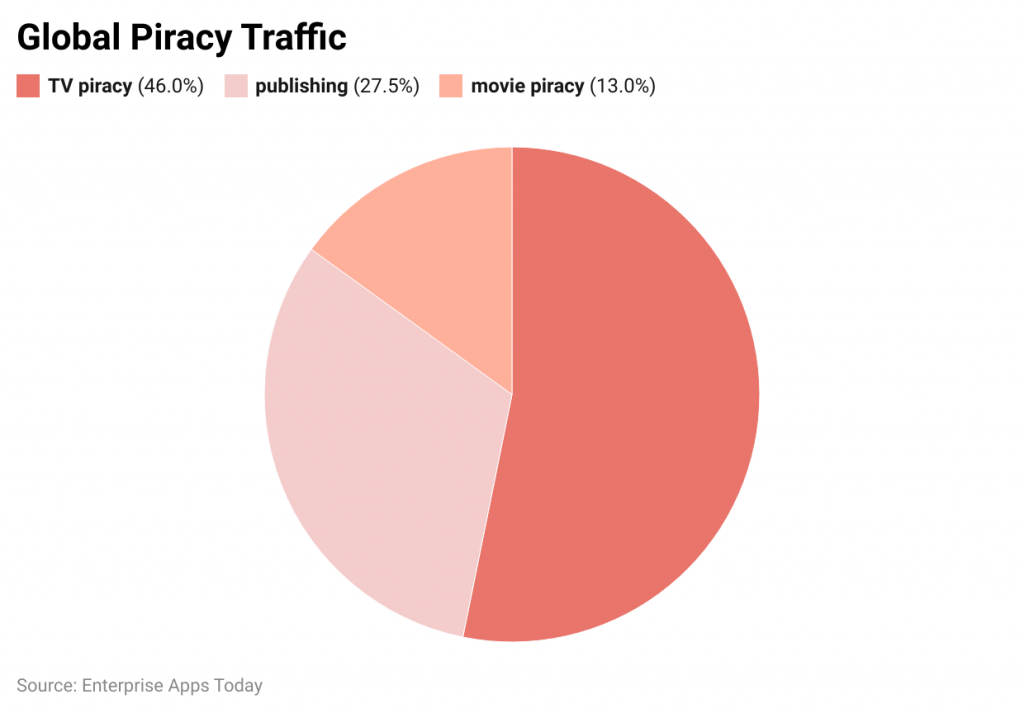
(Source: marketsplash.com)
As of 2023, the highest number of piracy traffic goes to TV piracy resulting in 46% while 27.5% is publishing, and move piracy contributes by 13%.
Piracy Statistics by mos pirated content on the Internet in 2023
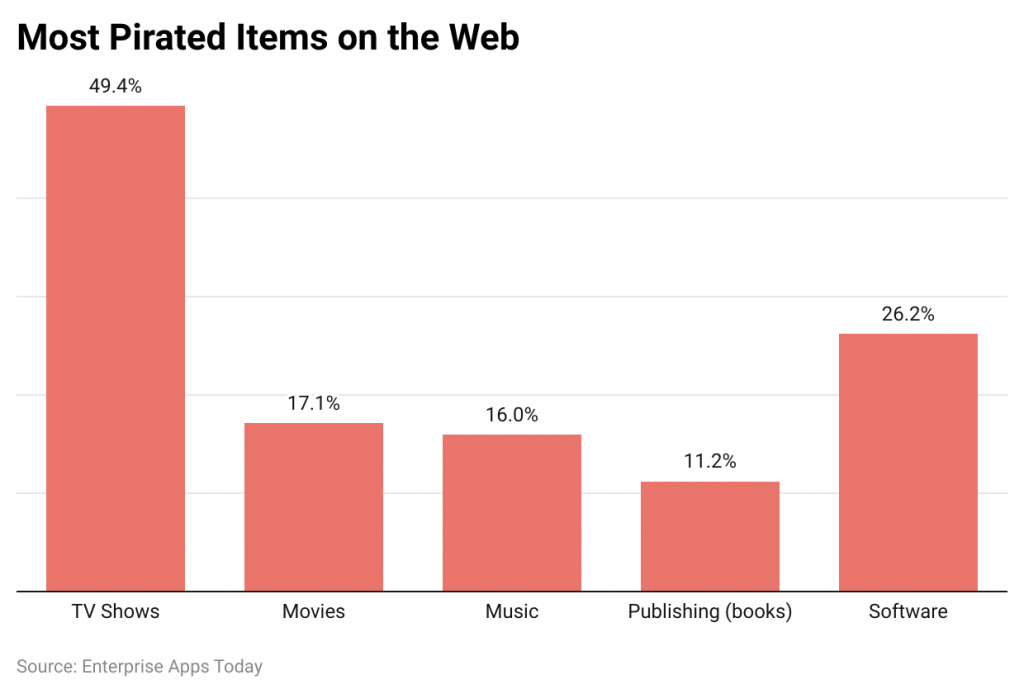
(Source: marketsplash.com)
On the Internet of Things, as studied by Piracy Statistics, the highest number of pirated content is found for Television shows (49.4%,), followed by Software (26.2%) and movies (17.1%).
Conclusion
Digital piracy seemed to be under control for a while. The piracy statistics seemed to be looking better, at least. How mistaken we were!
People often go illegal when trying to find their favorite TV shows and movies. While many pirates may not want to visit the most popular pirate movie websites, they are forced to because of the fragmentation of content across different streaming services. For example, if you love The Grand Tour and Game of Thrones, you will need to sign up for several services. Not only is that inconvenient, but it may also be expensive.
Furthermore, Andy Chatterley, MUSO's CEO, is probably the wisest. He says that we should stop thinking about this audience only as internet pirates. The reality is quite different from the fantasies. There's a lot of demand that streaming companies have been ignoring for years.
The statistics on media piracy, in Chatterley's opinion, demonstrate that businesses would lose their long-term conflict with pirates if they do not adapt:
Chatterley further stated, “It is crucial that the content industry embrace the trends emerging from this data, not only in strategic content protection but also understand the profile of the piracy ‘user' for improved business insight and monetizing these audiences.”
Moreover, online piracy appears to be a never-ending story with several seasons and players. A new player steps up to fill the void left by a fallen player. It can take many years to chase them down one by one. But let's hold out hope that the necessity for piracy statistics will be eliminated somewhere, someday in the future.
Sources
FAQ.
According to the most recent statistics on piracy, more than 1.2 billion songs are illegally downloaded annually.
Piracy is a significant threat to the movie industry worldwide. It has a reported revenue loss of between $40 and $97.1 billion.
Yes, copyrighted content distribution is a crime. Penalties include fines as high as $150,000 per file and up to five years imprisonment.
Over 300 billion people visited pirate websites in 2017 alone, according to MUSO, a business that monitors trends in piracy.
MUSO analyzed 2017, the number of visitors to each country is in billions.
Yes, it causes billions in revenue losses worldwide, costing the United States content industry between $29.2 and $71 billion per year. Music piracy also results in the loss of around 71,000 US jobs annually.
Yes, it is primarily due to the saturation in the streaming market that has led to consumers returning to piracy.
The global economy and the market value of each product can be affected by piracy. You can be punished and charged with a federal or criminal offense for piracy. Pirated content can also be used to spread malware, which is perhaps the worst. Pirated software could lead to data corruption or even loss. Other personal risks include identity theft and individual liability for criminal activity. Financial loss can also be caused due to fraud or lawsuits.

Barry is a lover of everything technology. Figuring out how the software works and creating content to shed more light on the value it offers users is his favorite pastime. When not evaluating apps or programs, he's busy trying out new healthy recipes, doing yoga, meditating, or taking nature walks with his little one.


